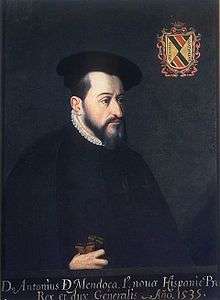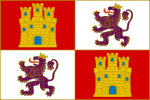Antonio de Mendoza
| Don Antonio de Mendoza | |
|---|---|
 | |
| 1st Viceroy of New Spain | |
|
In office April 17, 1535 – November 25, 1550 | |
| Monarch | Charles I of Spain |
| Succeeded by | Luis de Velasco |
| 3rd Viceroy of Peru | |
|
In office September 23, 1551 – July 21, 1552 | |
| Monarch | Charles I of Spain |
| Preceded by | Pedro de la Gasca |
| Succeeded by | Melchor Bravo de Saravia |
| Personal details | |
| Born |
Antonio de Mendoza y Pacheco c. 1495 Alcalá la Real, Jaén, Spain |
| Died |
July 21, 1552 (aged 56–57) Lima, Viceroyalty of Peru |
Don Antonio de Mendoza y Pacheco (Spanish: Antonio de Mendoza) (1495 – July 21, 1552) was the first Viceroy of New Spain, serving from April 17, 1535 to November 25, 1550, and the third Viceroy of Peru, from September 23, 1551, until his death on July 21, 1552.
Mendoza was born at Alcalá la Real (Jaén, Spain), the son of the Second Conde de Tendilla, Íñigo López de Mendoza y Quiñones and Francisca Pacheco. He was married to María Ana de Trujillo de Mendoza.
Viceroy of New Spain
Mendoza became Viceroy of New Spain in 1535 and governed for 15 years, longer than any subsequent viceroy. On his arrival in New Spain, he found a recently conquered territory beset with Indian unrest and rivalry among the Spanish conquerors and Spanish settlers. His difficult assignment was to govern in the king's name without making an enemy of Hernán Cortés. Cortés himself had expected to be made the permanent ruling crown official of New Spain, since he had led the Spanish conquest of the Aztec Empire. The Emperor Charles V (King Charles I of Spain) and the Council of the Indies judged Cortés too independent of crown authority to be made viceroy and had created a high court (audiencia) in New Spain in 1528, appointing Nuño de Guzmán, a rival of Cortés as its president to counter Cortés's power.[1] In 1530 Cortés was granted the title of the Marquis of the Valley of Oaxaca with multiple encomiendas. With the arrival of Viceroy Mendoza in 1535, Cortés pursued his own economic interests from his palace in Cuernavaca.[2]
Although the Spanish had occupied and expanded explorations, conquest, and settlement in the Caribbean, it was not until the conquest of central Mexico that the crown appointed a viceroy (vice king), who would be the king's living image in Mexico and envisioned to effectively assert royal authority in the Kingdom of New Spain.[3] Mendoza's status as a noble and his family's loyalty to the Spanish crown made him a suitable candidate for appointment.[4]
Don Antonio and Bishop Juan de Zumárraga were key in the formation of two institutions of Mexico: the Colegio de Santa Cruz at Tlatelolco (1536), where the sons of Aztec nobles studied Latin, rhetoric, philosophy and music, and the Royal and Pontifical University of Mexico (1552), modeled on the University of Salamanca, which trained young men for the Catholic Church. These institutions were the first and second universities respectively to be established in the mainland of the Americas. In 1536 he began the minting of silver and copper coins, known as macuquinas. Also under his instructions, the first printing press in the New World was brought to Mexico in 1539, by printer Juan Pablos (Giovanni Paoli). The first book printed in Mexico: La Escala Espiritual de San Juan Clímaco. On May 18, 1541 don Antonio founded the city of Valladolid (now Morelia, Michoacán).
In 1542 an insurrection of the Indians, called the Mixtón Rebellion threatened to push the Spaniards out of northwestern Mexico, bringing the area under indigenous control. The Viceroy himself had to take the field and bring all disposable manpower. The rebellion was quenched and the surviving Indians were harshly punished. By the viceroy's order men, women and children were seized and executed, some by cannon fire, some torn apart by dogs, and others stabbed.[5]
In 1544 the Emperor promulgated the New Laws abolishing slavery and gradually abolishing the encomienda. Mendoza, an ally of the encomenderos, was both unable and unwilling to enforce these laws in the face of rigorous opposition from the holders of the encomienda grants. When news reached Mexico of the civil war that had broken out in Peru over similar reforms, thought to undermine the rigorous encomienda system, he had the laws suspended and then revoked. In 1548 he suppressed an uprising of the Zapotecs.
As viceroy, Mendoza commissioned the expedition of Francisco Vásquez de Coronado to explore and establish settlements in the northern lands of New Spain in 1540-42, the expedition of Juan Rodríguez Cabrillo to explore the western coastline of Alta California in 1542-43, and the expedition of Ruy López de Villalobos to the Philippines in 1542-43. The Codex Mendoza is named for him. He probably commissioned it.
During his term of office, Mendoza is credited with consolidating the sovereignty of the Crown throughout the Spanish conquests in New Spain and limiting the power and ambition of the first conquistadors. Many of the political and economic policies he established endured throughout the entire colonial period. He promoted the construction of hospitals and schools and encouraged improvements in agriculture, ranching and mining. His administration did much to bring stability and peace to New Spain. He died in Lima.
He was succeeded as viceroy of New Spain by Don Luis de Velasco. It is reported that his advice to his successor was: "Do little and do that slowly."
Viceroy of Peru
On July 4, 1549 in Brussels, Emperor Charles V named Mendoza viceroy of Peru. He traveled overland from Mexico to Panama, and then by boat to Peru. He arrived and took up his new office on November 25, 1550. However, he soon became ill, and died in 1552. His tomb is in the Cathedral of Lima, along with that of the Spanish conqueror of Peru, Francisco Pizarro.
Mendocino County, California and Mendocino National Forest are named in his honor.
Notes
- ↑ Ida Altman, The War for Mexico's West. Albuquerque: University of New Mexico Press 2010, p. 21-22.
- ↑ Ida Altman, et al. The Early History of Greater Mexico. Pearson 2003, 69.
- ↑ Alejandro Cañeque, The King's Living Image: The Culture and Politics of Viceregal Power in Colonial Mexico, New York: Routledge 2004.
- ↑ Altman et al, Early History of Greater Mexico, p. 69.
- ↑ Juan Comas, "Historical Reality and the Detractors of Father las Casas". In Juan Friede and Benjamin Keen (eds.), Bartolomé de las Casas in History: Toward an Understanding of the Man and his Work. Collection spéciale: CER. DeKalb: Northern Illinois University Press, p. 493.
References
- (Spanish) "Mendoza, Antonio de," Enciclopedia de México, v. 9. Mexico City, 1988.
- (Spanish) "Mendoza, Antonio de," Encyclopædia Britannica, v. 6. Chicago, 1983.
- (Spanish) García Puron, Manuel, México y sus gobernantes, v. 1. Mexico City: Joaquín Porrua, 1984.
- (Spanish) Orozco Linares, Fernando, Gobernantes de México. Mexico City: Panorama Editorial, 1985, ISBN 968-38-0260-5.
External links
 Media related to Antonio de Mendoza at Wikimedia Commons
Media related to Antonio de Mendoza at Wikimedia Commons- "The First and the best: Viceroy Antonio de Mendoza"
| Government offices | ||
|---|---|---|
| Preceded by Newly Established |
Viceroy of New Spain 1535–1549 |
Succeeded by Luis de Velasco |
| Preceded by Pedro de la Gasca |
Viceroy of Peru 1550–1551 |
Succeeded by Melchor Bravo de Saravia |

